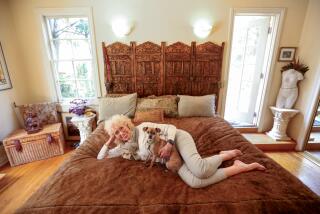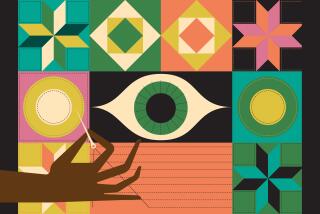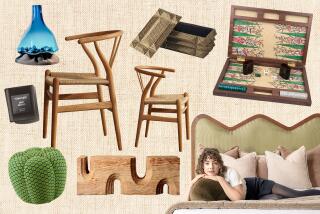More Than Just Fluff : European Down-Filled Comforters Are Putting Heavy Bedspreads to Rest
- Share via
Beds, the traditional kind flanked by two pillows and covered with a single bedspread, are being made over.
“Hotel beds,” as one interior designer dismisses beds with bedspreads, are passe. Beds are now multilayered and overstuffed.
The simple quilted bedspread has been replaced by a fluffy down comforter snuggled inside a colorful comforter cover. Often the comforter is folded down to reveal an embroidered blanket cover and accompanied by a coordinating dust ruffle or bed skirt and no less than a dozen pillows.
At Christine’s Fine Linens in Costa Mesa, Manager Christine Sceberras points to her dwindling supply of bedspreads tucked away in a remote corner of her store.
“They’re all going,” she says. “Pretend you don’t even see those.”
The duvet or comforter is a European staple that only in recent years has eclipsed the bedspread in America.
“Bedspreads are an old-fashioned idea,” says Sandra Marx, co-owner of Between the Sheets in Fashion Island, Newport Beach. Comforters weigh less than bedspreads, she says, because they don’t extend to the floor. People prefer not having to remove the heavy spread every night and sleeping under the lightweight comforter.
“People also discovered down comforters can look very formal with a duvet cover,” she says. “Bedspreads have never recovered.”
Many Americans, though, are in the dark when it comes to choosing a down comforter.
“A lot of people race out and buy a cheap one,” she says. They also err by judging a comforter by its weight, she says.
“The lady who calls and asks ‘How many ounces is it?’ is my worst nightmare,” Marx says.
That type of buyer often ends up with what Marx calls a “50-ounce behemoth that spends its whole life in the closet with the skis.”
“The whole function of down is that it’s weightless so the body can turn and shift while sleeping,” she says.
Buyers should be more concerned about the percentage of down to feathers, she says. Feathers are heavy and hot. Down consists of airy clusters that insulate the sleeper from heat or cold.
U.S. manufacturers can legally advertise a comforter as 100% down even though it may contain up to 30% feathers, Marx says. In Europe, however, 5% feathers is the limit.
“Unless your grandmother is the one plucking the feathers, you can’t do better than that,” Marx says.
Premium down comforters are made from the down of geese from Hungary and Poland--chilly countries where the birds produce the largest down clusters to ward off the cold, she says.
The ideal comforter shell is made from a tightly woven 300-thread count cotton so the down fibers can’t escape. The shells have large quilted squares to keep down from collecting in one “hot spot.” Fine mesh is sewn in between the seams so air can pass in and out of the squares.
The finished product is a soft, fluffy affair that at Between the Sheets goes for about $1,000 for a king size.
Duvet covers, the equivalent of pillow cases for comforters, have become popular because they can be washed or replaced, Marx says. The covers come in decorative fabrics to suit every taste.
The finest duvet covers are made of long Egyptian cotton threads brushed until they feel “like butter,” Sceberras says.
Christine’s carries duvet covers in muted solid colors such as pale rose and ivory with woven Jacquard prints of paisley, stripes or florals. There are satiny covers in vivid jewel tones including purple and gold.
The store’s top-of-the-line duvet cover is of lush ivory Egyptian cotton with tiny embroidered rosebuds that sells for $521 for a king size.
“There’s only one loom in Germany that makes it--and it’s hidden in a forest,” Sceberras says.
Between the Sheets has duvet covers inspired by fine art, including floral prints that look like antique tapestries, muted watercolors in soft pastel shades, Picasso-style patterns with squiggles and spirals and bold Miro-inspired abstracts in colors like mango and turquoise. There are covers made of silk in rich hues of gold, blue and burgundy with Jacquard finishes.
Sheridan in South Coast Plaza, Costa Mesa, has comforter covers that range in design from Old World to contemporary. There’s a china-blue floral print, a Botticelli-inspired pattern with twisting vines and fruit in deep shades of terra cotta, navy and green, and a “Coral Reef” print with bright orange fish floating in a turquoise sea.
Sceberras traces the trend toward decked-out beds piled high with lush comforters and pillows to the retreat from a hectic world.
“Because of the fast-paced life, people like to come home and relax,” she says. “The bed is like a sanctuary where you can restore your health.” And get a decent night’s sleep.
More to Read
Inside the business of entertainment
The Wide Shot brings you news, analysis and insights on everything from streaming wars to production — and what it all means for the future.
You may occasionally receive promotional content from the Los Angeles Times.










